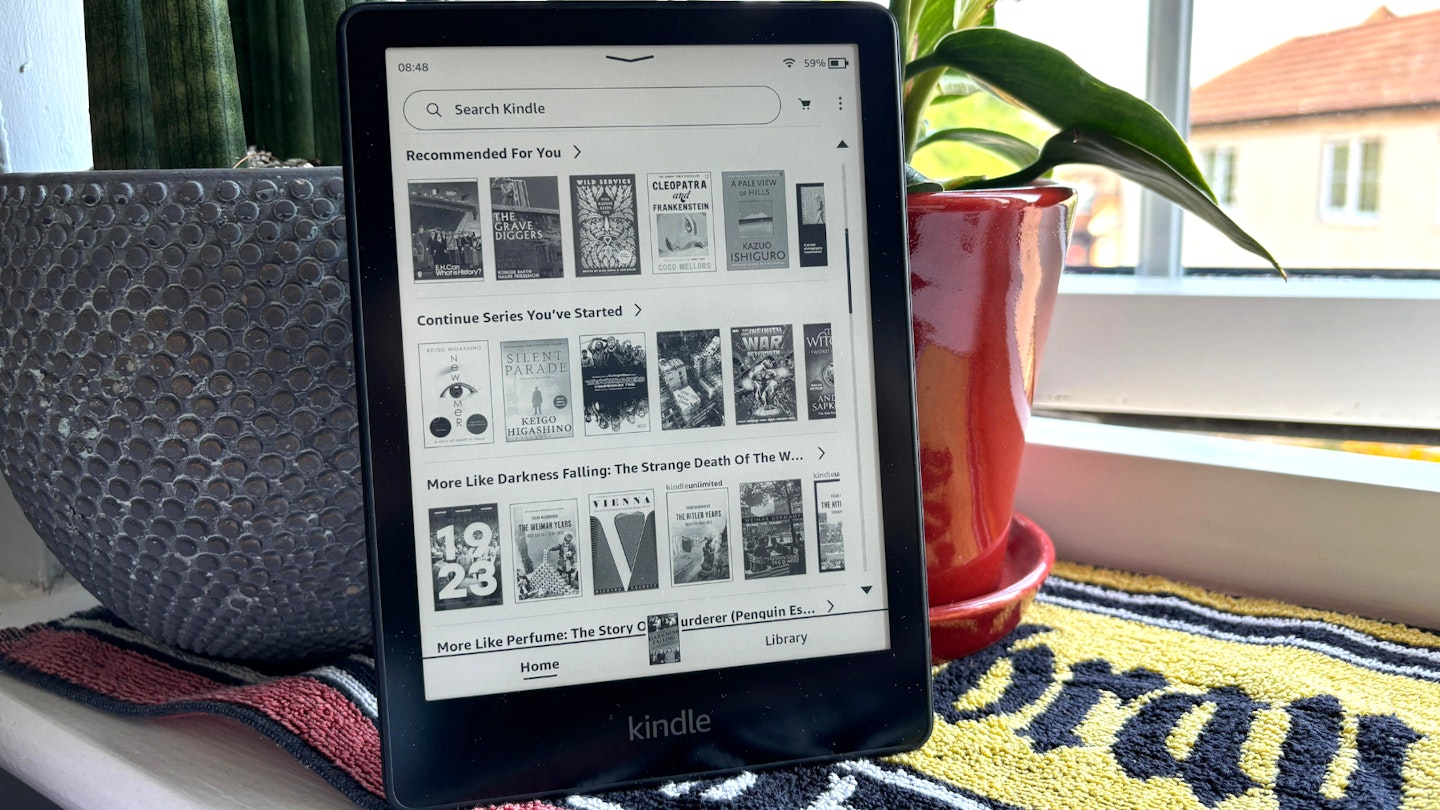The Kindle Paperwhite is the most popular e-reader from Amazon, offering a notable improvement in features over the base model while steering clear of the high price called on by the next step up – the Kindle Oasis. While being easily one of the best Kindle options, can it convert a dedicated paperback reader?
William Austin-Lobley, editor of What's The Best, has had a lifelong love affair with the printed word. With two English degrees and four stuffed bookcases, he has long resisted switching to the world of Kindle libraries. But in 2024, and getting weary of carrying around hefty novels (and short of shelf space), he's picked up the Paperwhite to see if it can convert him into a digital bookworm. Read on to see his hands-on review after spending a few weeks reading fiction and nonfiction on the Kindle Paperwhite.
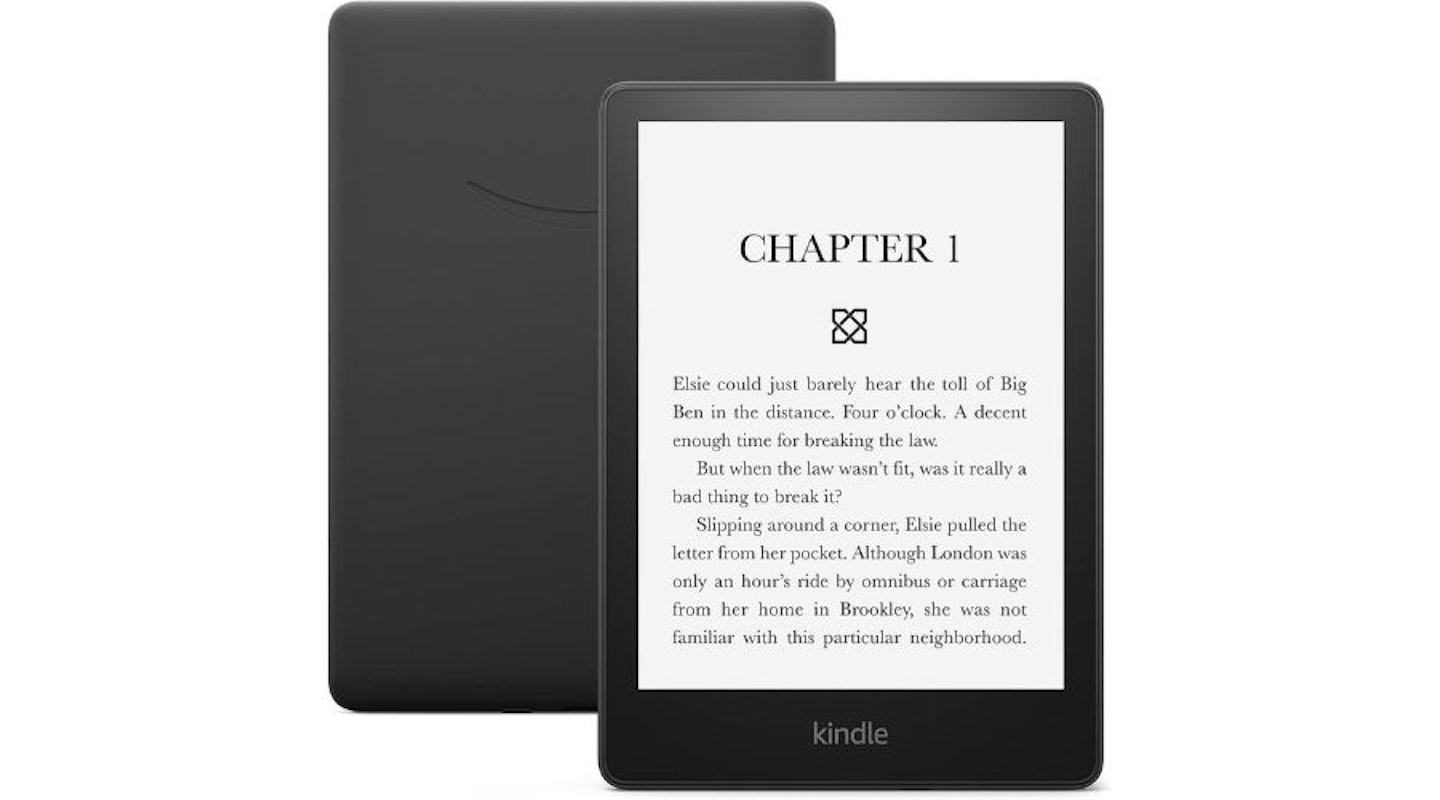
Pros
- Excellent screen for reading in all conditions thanks to E Ink and backlight
- 300 ppi screen makes for sharp reading and clear images
- Accessible features to optimise experience, including Bluetooth for audiobooks
- Easy store navigation and downloading
- Light and portable
Cons
- Pay more for the ad-free version
- Locked into the Kindle Store
| IP Rating | IPX8 |
| Storage | 16GB |
| Charging | Fully charges in approximately 5 hours from a computer via USB cable; fully charges in less than 2.5 hours with a 9 W USB power adaptor. |
| Battery life | Up to 10 weeks |
| Screen | 6.8" E Ink, 300 ppi |
| Weight | 205g |
What's the difference between the Kindle and the Kindle Paperwhite?
The Kindle, launched in 2007, has been a staple with readers looking for a portable and convenient way to carry their library. The current basic model, the Kindle we recently reviewed, features a 167 ppi six-inch display, 4GB of storage for thousands of books, weeks of battery life, and weighs just 174g. It's the entry-level device in the Kindle range, designed to offer a straightforward, enjoyable reading experience – and it does so brilliantly.
The Kindle Paperwhite is a step up over the base Kindle (2022). Amazon launched the range in 2012, offering several enhancements over its cheaper sibling. Most notably, the Paperwhite has a higher-resolution 300 ppi 6.8-inch display, which provides sharper text and images, and has an adjustable front light, allowing for comfortable reading in any lighting conditions. The Paperwhite offers an improved battery life of up to ten weeks and is waterproof with an IPX8 rating, but weighs slightly more. It also has 16GB of storage, ideal for holding more books and audiobooks, though the Paperwhite Signature edition goes further and has 32GB.
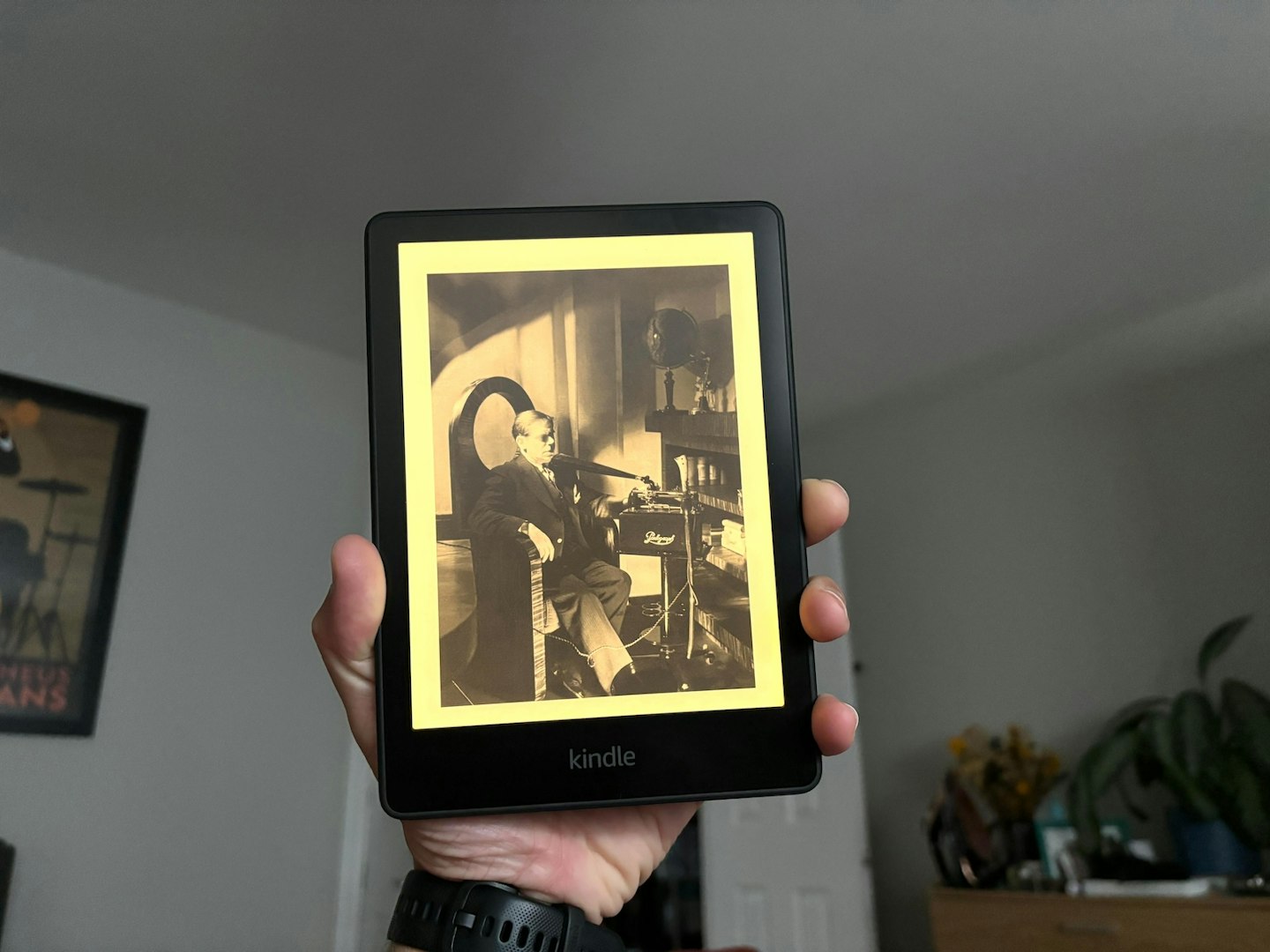
Both the Kindle (2022) and Kindle Paperwhite support the same vast library of eBooks, easily accessible from Amazon's in-built store. They also have similar software features, including dictionary integration and adjustable font sizes.
Which is best for me?
The Paperwhite's enhanced display, lighting, and waterproofing make it a superior choice for those who read in various environments and conditions. However, if budget is paramount, the Kindle (2022) is still going to offer a great reading experience.
First impressions setting up and reading on the Kindle Paperwhite
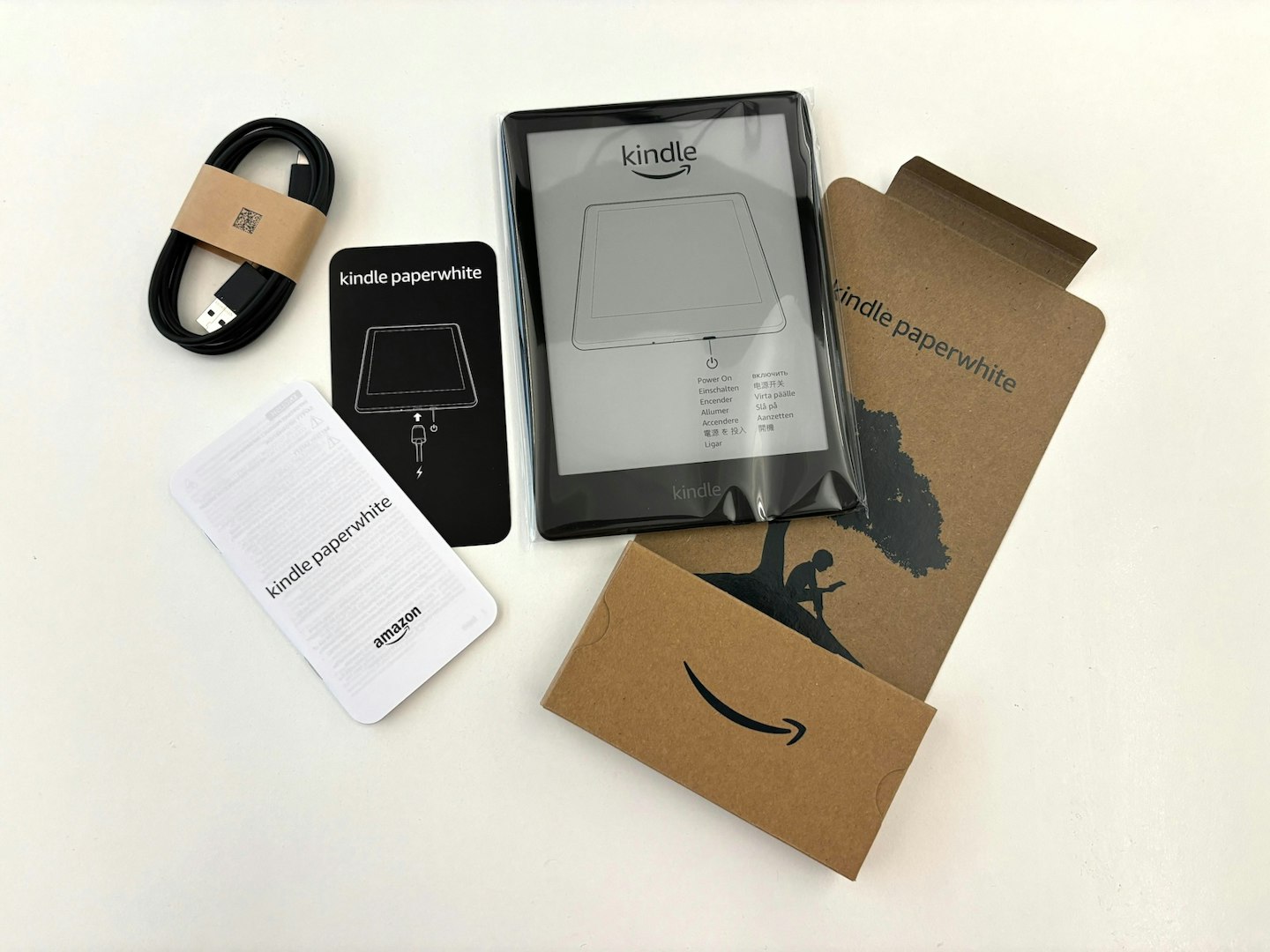
The Kindle Paperwhite has a refreshingly simple setup process. All you need is your Wi-Fi password and Amazon account details, and you're ready to delve into a world of digital reading. The device follows a series of well-designed and light tutorials which guide you through the essential functionalities, including accessing settings, navigating the home screen, and exploring the Kindle Store.
During setup, Amazon will offer a free trial of Kindle Unlimited, which I took, and Audible, which I passed over. The Kindle Unlimited catalogue is impressive, and though the fiction selection isn't entirely to my tastes, I managed to find some excellent historical titles (Darkness Falling: The Strange Death of the Weimar Republic, 1930-33 by Peter Walther and In Defence Of History by Richard J Evans, in case you're interested), though my first foray into the Kindle world began with a purchase of Perfume by Patrick Suskind and the experience was excellent. This excellence is all down to the screen, which I'll touch on shortly.
Accessing and navigating the Kindle Store is a breeze, as it's completely integrated into the home screen. There are loads of sections to browse and a search function to hunt for a specific read. Once you select a title to download and pay via your linked Amazon account, a book will be ready to download. I've tried downloading from a 5G tether to my iPhone and via home Wi-Fi – in both instances, the download took under a minute. All you need to do then is get reading.
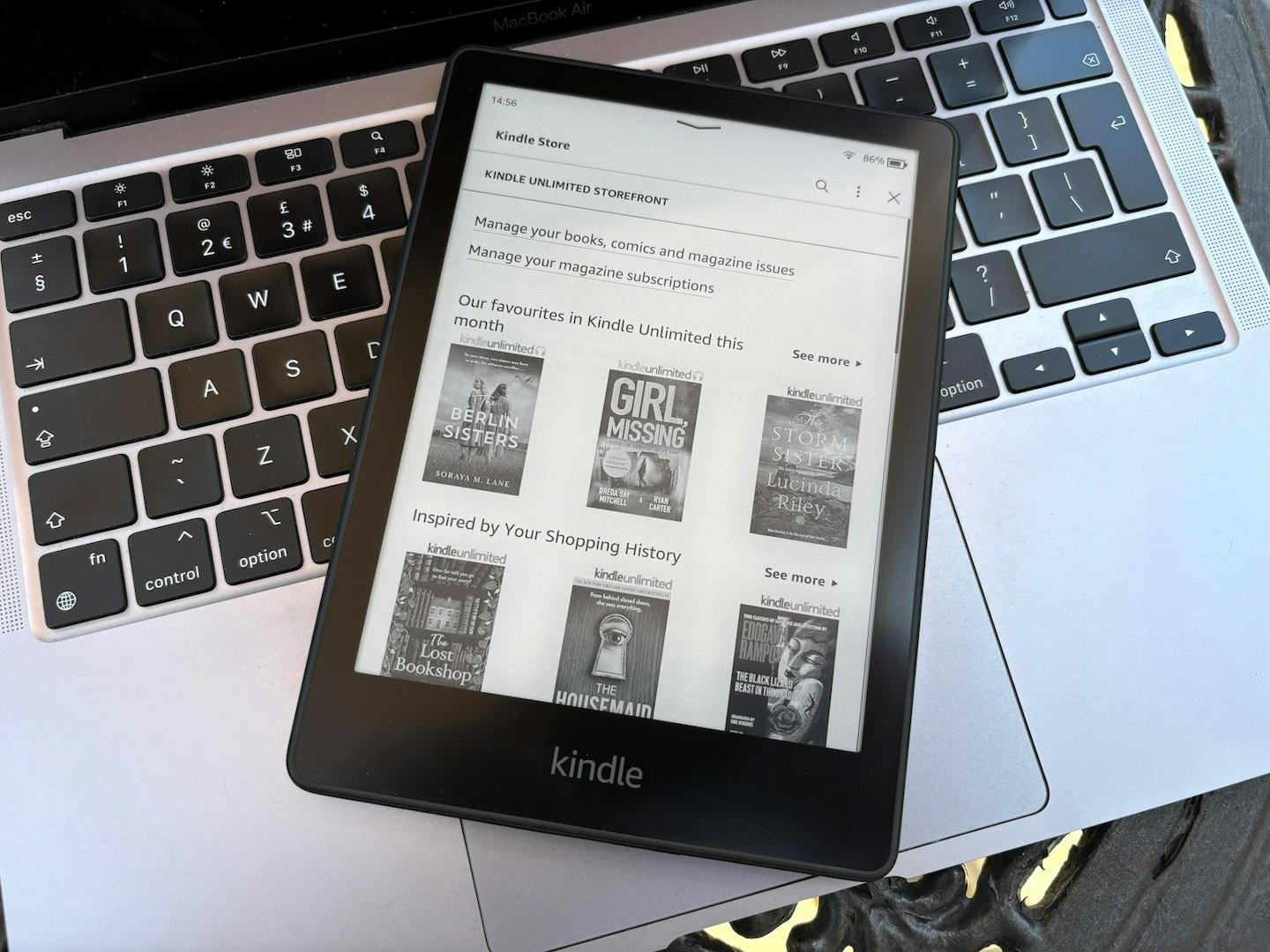
You can also access your Amazon wish lists through the Kindle's interface, so if you are like me and have a reading backlog saved to your account, you can skim through and see what's available. It will tell you which are available to purchase outright or accessible on Kindle Unlimited (or even at a heavy discount via Prime Reading, a somewhat needless third tier of Kindle Store discounting).
New Kindle users should be prepared to spend their first few hours slipping between reading and tinkering with settings to maximise their reading experience. This includes customising font sizes and styles (including a dyslexia-friendly font), adjusting margins and line spacing, and choosing the information displayed on the screen, such as the remaining time in a chapter or book. Luckily, these are all easy changes to make on the fly. For me, I stripped the interface right back to basics with a few taps of the screen.
Controls
Controls are intuitive. There’s a button at the bottom for locking and unlocking the device, or hold it down to power it on and off. Operating the device is via the touchscreen, where swiping as you would on a smartphone or tablet moves pages around and brings up menus.
When reading, tapping the screen will turn the page. It’s all very straightforward and works without trouble.
Built-in tools
The Kindle Paperwhite offers several handy tools – called X-Ray – for exploring information and defining words as you read. Its built-in dictionary is a standout feature, functioning entirely offline - tap to highlight any word and see its definition instantly without needing an internet connection.
The exact process can be used for accessing translations of words in other languages, though this does require an internet connection (unless you download a language's dictionary to your Kindle.
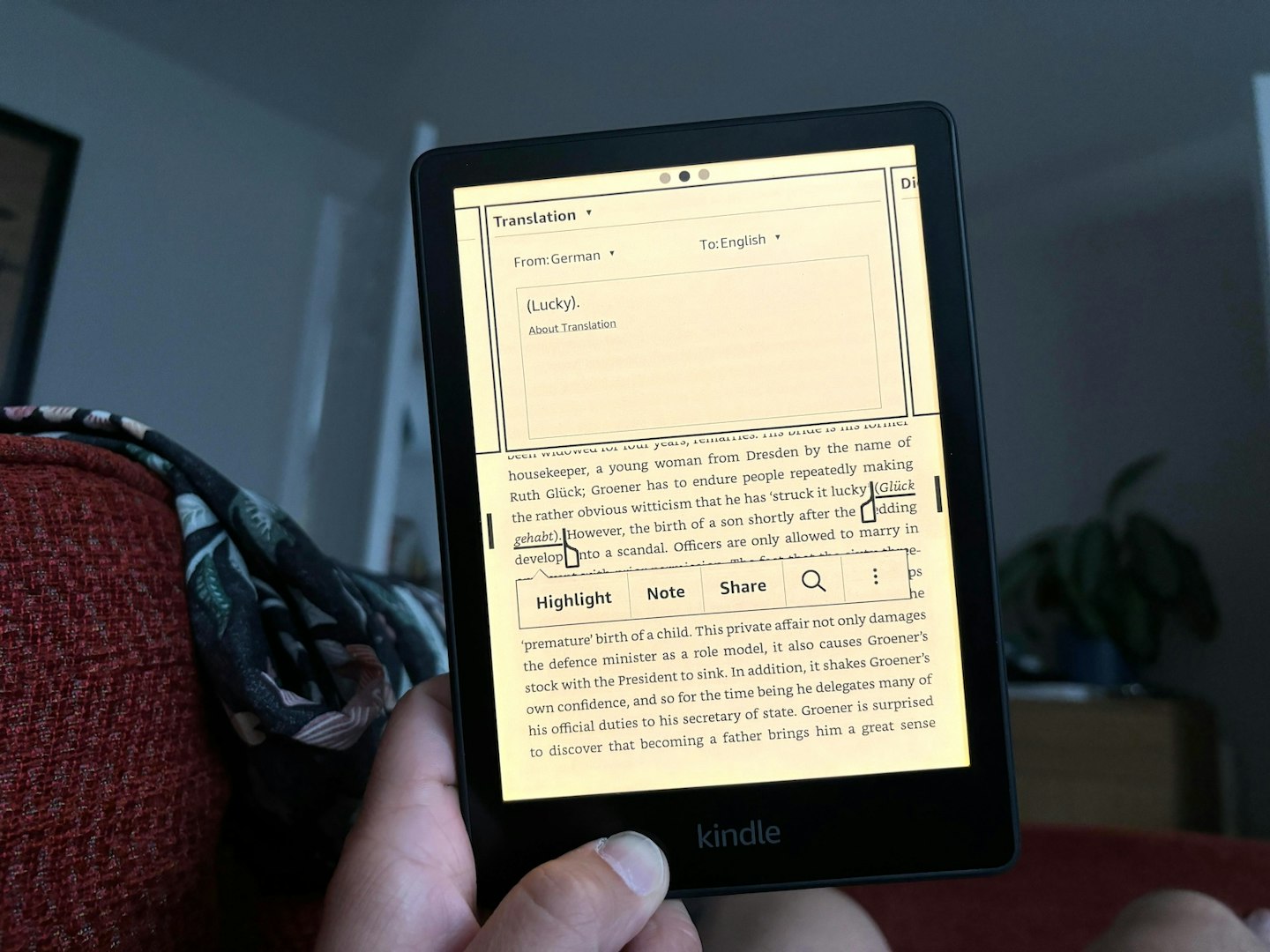
If you are reading a book with footnotes, these are highlighted – tap them and the footnote will pop up, saving you from jumping around in the book.
My favourite reading feature, however, is the support for Wikipedia. Highlighting a word or phrase can provide a brief definition and allow you to read a full Wikipedia article on the subject. This is great for refreshing your memory, especially when reading nonfiction works.

Bluetooth for audiobooks
Like all Kindles, the Paperwhite has Bluetooth capability, which allows you to connect headphones or speakers to your device to listen to audiobooks – this is particularly useful for Audible subscribers. With Bluetooth pairing, you can listen to audiobooks while following along with the text on your Kindle Paperwhite's screen. This feature creates a seamless, synchronised reading and listening experience.
I recommend that those keen on audiobooks and who like the look of the Paperwhite consider the Signature Edition Paperwhite, which has 32GB of storage and is ideal for listening on the go.
The hero of the piece: the E Ink screen
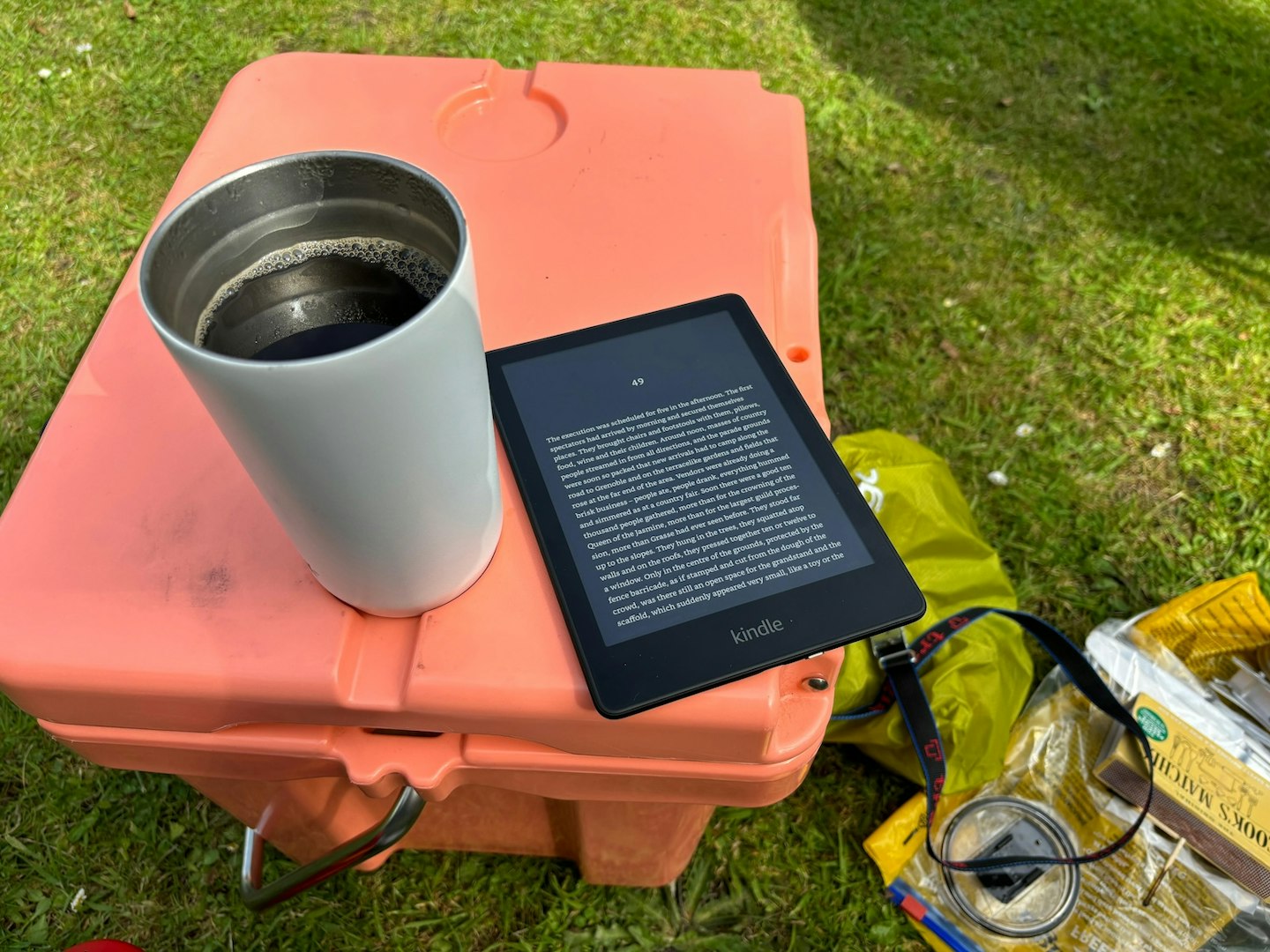
The E Ink screen is a joy to read, offering a remarkably paper-like experience. The display boasts a gentle contrast, with blacks that mimic the softness of printed text rather than the harshness of a lit screen. This subtlety, paired with the ability to adjust the screen's warmth, creates an incredibly close replica of reading a physical book. As a former paperback fanboy, I found this feature surprisingly organic when switching to e-reading.
Kindles boast legendary battery life thanks to E Ink. While LCD screens, like those on your smartphone or tablet, constantly use power to illuminate pixels, E Ink uses millions of tiny capsules containing black and white pigments which, when an electric field is applied, rotate, displaying the desired image. Once the image is set, no power is needed to maintain it; it just holds that image indefinitely. This allows Kindles to achieve weeks of battery life on a single charge, as it only uses power when refreshing the image on the screen – for example, when you 'turn' a page.
However, there's a factor to consider with some Kindle models, particularly the Paperwhite. These models have a built-in front light to illuminate the E Ink display for reading in low-light environments. While this light is a fantastic feature for nighttime reading, it does consume some power and emits a small amount of blue light. The good news is that you can still significantly improve battery life by adjusting the brightness of the front light. Lowering the light level uses less power and is sufficient for reading in most situations. I used Dark Mode, which switches the colours to a black page with white text, perfect for reading at night and helping me relax into bed.
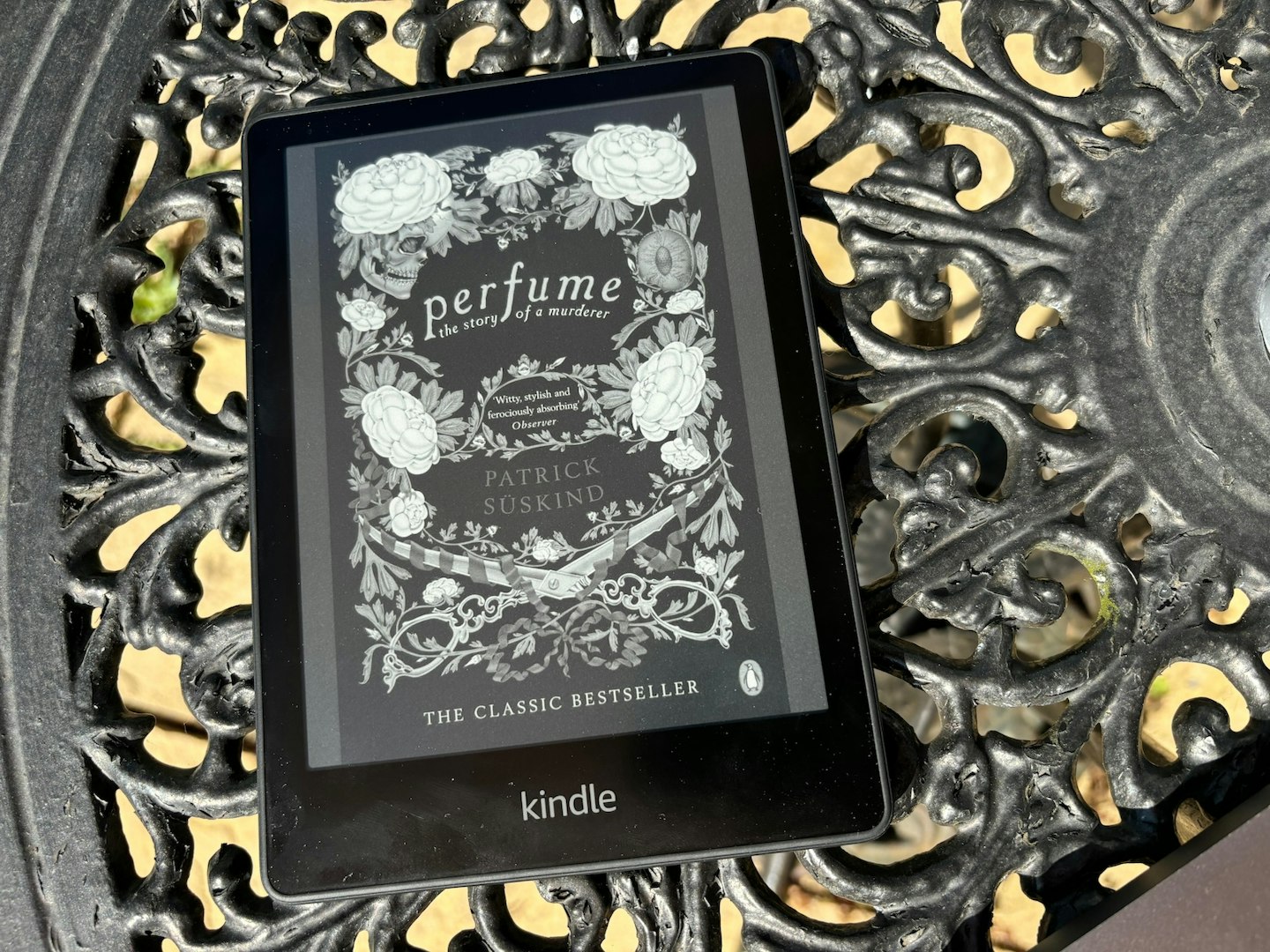
Another string to the E Ink's bow that I particularly enjoy is that it can be read in direct sunlight. As something of a sun-seeker, I often bump into issues with the gloss screens of laptops and smartphones in the summer. However, the matte finish of the E Ink screen makes it readable. Perfect for reading in the garden, by a bright window, or on holiday.
Any issues?
You have to pay to remove ads, which is frustrating. If I buy a product, why should I still be subject to advertisement on a piece of my property? Also, I've bought the Kindle – of course, I am going to purchase books through the Kindle Store – you've got me Amazon; why are you still trying to give me the hard sell? But alas, that's Amazon's prerogative and a sign of the times.
Regarding features, there's an internet browser, but the Kindle Paperwhite lacks the power or programming to run specific internet scripts. This severely limits its scope, and Amazon makes a point of telling you so when you load it up for the first time. Regardless, I tried loading up What's The Best's homepage and crashed my Paperwhite. A version of the Kindle Store and Wikipedia is accessible, but the experience is still very limited.
I only highlight this if you've seen that this Kindle carries an internet browser and expect something close to a tablet experience, as you'd find on something from the Fire range. You won't – it's weak. But it's an e-reader, so really, it's nothing that should stop you from grabbing the Paperwhite.
Price and competition
If you are wondering which e-reader to buy, the chance is that you are simply weighing up which Kindle to buy. The base model, the Kindle (2022), offers a staggeringly low entry price at only £85. It's a fine choice, especially for those with easy access to good lighting.
For £230, the Oasis shimmers into view and seeks to entice digital readers with its comfy, grip-friendly design, slightly larger screen, and automatic light adjustment. Nice touches, yes, but whether this is worth an extra £50 is something you'll have to decide on yourself – though, to be clear, I don't consider it worth it.
Having reviewed the other options tested by my colleagues, the Paperwhite is the most compelling choice, with its pin-sharp screen and illumination, just-right additional features, and long battery life.
Rakuten Kobo e-readers are an alternative brand that may attract e-reader fans. The tech is very similar, and Kobo isn't locked to a specific store, meaning you can download books from multiple locations. However, the slightly lower price, Prime shipping and integration with Amazon make Kindles a more popular pick.
Paperback books remain a strong competitor to the Kindle Paperwhite despite its convenience. Book lovers cherish the physical experience of turning pages, the feel of the paper, and annotating margins. While Kindle purchases are typically half the price of a physical copy, the paperback market is full of perfectly acceptable used books and library rentals.
A note on pricing
The prices discussed here are the "Starting from" price and reflect the most annoying thing about buying a Kindle: paying for the removal of advertisements. Kindles with Ads offer a lower price upfront in exchange for displaying sponsored screensavers and lock screen ads. These can be removed for a one-time fee, letting you choose between immediate savings or an ad-free reading experience. That's not something you have to bargain for with paperbacks.
Who is it for?
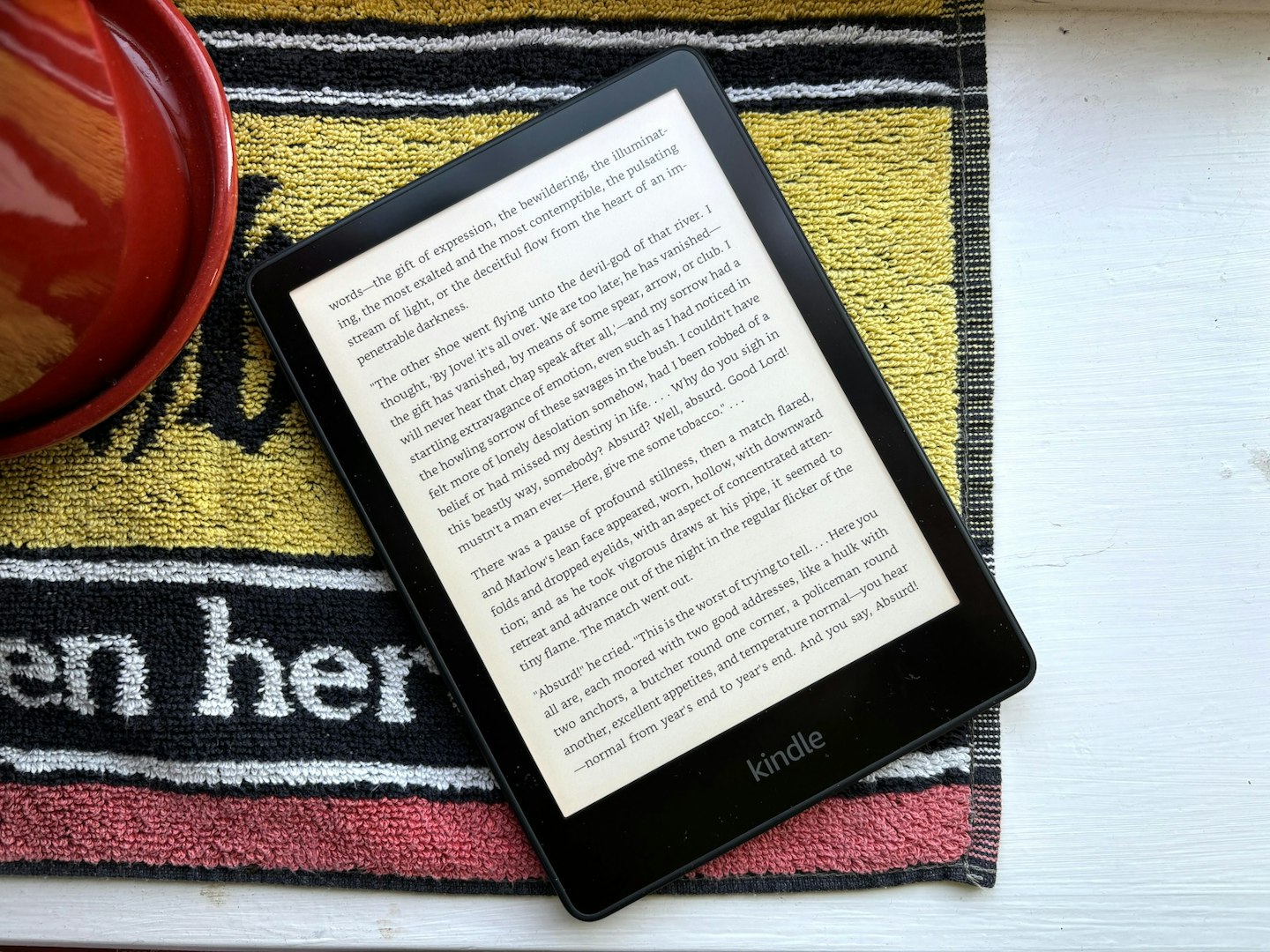
The Kindle Paperwhite is ideal for avid readers who seek a versatile, high-quality e-reader that balances advanced features with affordability. It caters to those who appreciate the convenience of digital reading but also desire a sharp, high-resolution display and adjustable front light for comfortable reading in various lighting conditions. It's well-suited for audiobook enthusiasts due to its Bluetooth capability and compatibility with Audible.
Would we recommend it?
Yes, I'd recommend the Kindle Paperwhite to pretty much anyone who loves reading. It won't completely replace my physical collection, but for reading books en masse and saving space and money, this e-reader is going to come in very, very handy.
I've really enjoyed reading on its high-resolution display, not worrying about charging it thanks to its extended battery life and reading at night using the adjustable front light.
While the base Kindle (2022) offers a great entry-level option, the Paperwhite's additional features justify the extra cost for those who really love to read.
Similar products to consider
The Kindle (2022) is the base model Kindle, and a great alternative to the Paperwhite for those on a budget.
Pros
- Fantastic value e-reader
- Great lightweight design and strong build quality
- Excellent battery life
Cons
- Sluggish user interface
3.
Kindle Oasis

For a more premium expereince, consider the Oasis.
Pros
- Comfortable form
- Excellent reading experience
- Automatic light
Cons
- Much more expensive than the Paperwhite
Who tested it
William Austin-Lobley, the editor of What's The Best and lifelong bookworm, tested the Kindle Paperwhite. His tastes are broad, spanning classic works of English literature to translated Japanese crime fiction and graphic novels and comics (think Tintin rather than anything Marvel). He reads mostly fiction but has a seemingly endless desire to read non-fiction about anything between 1900 and 1950. In addition to reading, William has a background in technology writing and reviewing.
How was it tested
There's only one way to test a Kindle: you read books on it. So, William read three books on it. Over two weeks, the Kindle Paperwhite was tested in various environments, including outside, in the office, in bed, and lounging on the sofa. It was also taken on a camping trip, demonstrating its portability and durability. Numerous titles were downloaded, and the Kindle Store was thoroughly explored to evaluate its ease of use and accessibility.
During testing, settings were adjusted and customised to optimise the reading experience. The adjustable front light, font styles, and sizes were played with to see their effects, ensuring that the device could cater to different reading preferences and conditions. This hands-on approach provided a comprehensive understanding of the Kindle Paperwhite's capabilities and performance in real-world scenarios.
Why should you trust us?
At What’s The Best, our mission is to provide accurate and reliable reviews, ensuring our readers receive honest and transparent information about the best technology products available. Anything less would undermine our commitment to being a trusted source of unbiased product information.
Our dedicated in-house writing team comprises experts with extensive experience and a genuine passion for technology. Collectively, we have spent decades testing and writing about tech, leveraging our expertise in all our articles, advice pieces and reviews.
We maintain complete editorial independence and do not accept payment for product reviews. Our writers have full control over their content, ensuring that products are selected based solely on the needs of our readers. While we may earn commissions or other compensation from links on our website, this never affects our product choices. These links enable us to continue offering valuable consumer advice, without compromising the integrity of our reviews.
How What's The Best test products
Real people, real reviews and trusted buying advice.
Tired of confusing tech reviews? At What's The Best, we cut through the jargon with down-to-earth product evaluations. Our team of experienced reviewers puts everyday gadgets to the test, using them just like you would. We don't waste time on unrealistic scenarios; instead, we focus on real-world performance that matters to consumers.
This means unbiased buying advice you can trust. We only review products that are significant and relevant, so you can be sure you're getting the latest insights. Haven't seen a review for what you're looking for? Don't worry, we're constantly adding new products to our growing catalogue.
For in-depth details on our testing process, visit our dedicated tech and electronics how we test page.
William Ausitn-Lobley is the Editor for What's The Best. Here, he oversees, curates and researches listicles and reviews as many products as his home office can handle.
He has spent nearly five years writing about tech, audio, outdoors and fitness and has reviewed everything from smartphones to ice baths. In addition, he's well-versed in sniffing out the best deals and savings the internet offers.
When not at his desk writing, reviewing or deal-hunting, he'll be relaxing with Japanese crime novels, bingeing some classic anime, strolling the countryside or at the gym listening to the heaviest metal Spotify has to offer.
Subscribe to the What’s The Best Newsletter to keep up to date with more of the latest reviews and recommendations from the What’s The Best team.
